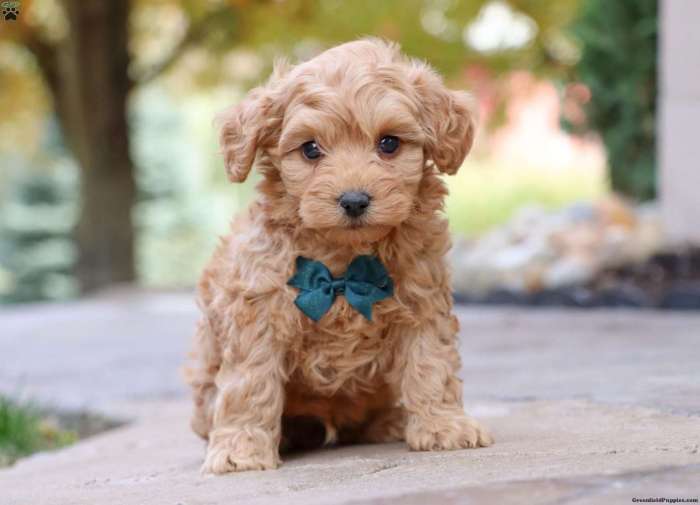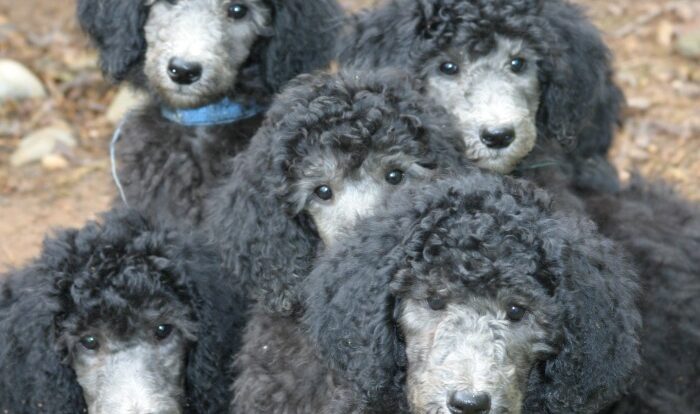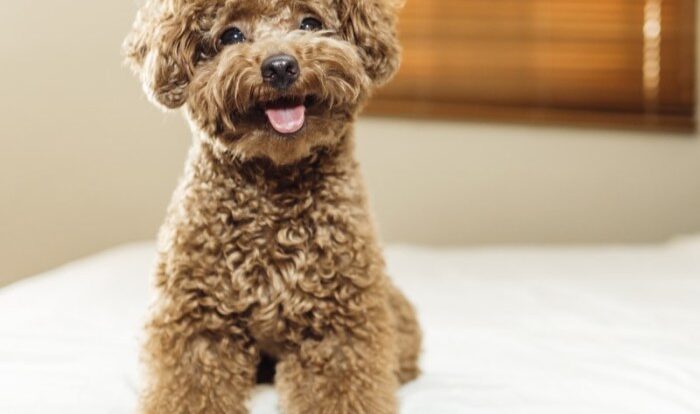Schnoodle puppies, known for their unique characteristics and charm, require specific care and attention to thrive. From grooming needs to health considerations, this comprehensive guide covers everything you need to know about raising a happy and healthy Schnoodle puppy.
Whether you’re a first-time owner or looking to expand your knowledge, this guide will equip you with valuable insights and tips to ensure a fulfilling journey with your Schnoodle companion.
Characteristics of Schnoodle Puppies

Schnoodle puppies are a delightful mix of Schnauzer and Poodle breeds, resulting in a unique combination of characteristics that make them popular among dog lovers.
Physical Appearance
Schnoodle puppies typically have a fluffy coat that can come in a variety of colors such as black, white, silver, or apricot. They have expressive eyes, a black nose, and floppy ears that add to their adorable appearance.
Temperament and Behavior Traits
Schnoodle puppies are known for their friendly and affectionate nature. They are intelligent, eager to please, and are quick learners. They get along well with children and other pets, making them excellent family companions.
Size Variations, Schnoodle puppies
Schnoodle puppies can vary in size depending on the size of their Schnauzer and Poodle parent breeds. They can range from small to medium-sized dogs, with some falling in the toy or miniature categories. This variety in size allows potential owners to choose a Schnoodle that fits their lifestyle and living space.
Hypoallergenic Nature
One of the appealing traits of Schnoodle puppies is their hypoallergenic coat, inherited from their Poodle lineage. This makes them a great choice for individuals with allergies to pet dander, as Schnoodles shed less and produce less allergens, providing a more hypoallergenic environment.
Caring for Schnoodle Puppies

When it comes to caring for Schnoodle puppies, there are several important aspects to consider in order to ensure their health and well-being.Grooming Requirements:
Grooming Requirements
Grooming is an essential part of caring for Schnoodle puppies. Their curly coats require regular brushing to prevent matting and tangling. It’s also important to trim their hair around the eyes and ears to prevent irritation and infection.
- Brush their coat at least 2-3 times a week.
- Trim their nails regularly to prevent overgrowth.
- Regularly check and clean their ears to prevent infections.
Dietary Needs:
Dietary Needs
Proper nutrition is crucial for the health of Schnoodle puppies. It’s important to provide them with a balanced diet that meets their specific needs.
- Feed them high-quality puppy food that is appropriate for their size and age.
- Avoid feeding them table scraps or human food, as it can be harmful to their health.
- Ensure they have access to fresh water at all times.
Exercise Routines:
Exercise Routines
Regular exercise is important for Schnoodle puppies to maintain a healthy weight and stay active.
- Take them for daily walks or play sessions to keep them active and engaged.
- Engage them in interactive toys or games to stimulate their minds and bodies.
- Provide them with opportunities to socialize with other dogs to promote healthy behavior.
Training Tips:
Training Tips
Training is essential for Schnoodle puppies to learn good behavior and manners.
- Use positive reinforcement techniques such as treats and praise to encourage good behavior.
- Be consistent with training routines and commands to help them learn quickly.
- Enroll them in puppy training classes to socialize them and learn essential skills.
Health Considerations for Schnoodle Puppies

When it comes to the health of Schnoodle puppies, it’s essential to be proactive in preventing common health issues and knowing how to handle emergencies. By following a proper vaccination schedule and providing the necessary care, you can ensure your Schnoodle puppy stays healthy and happy.
Common Health Issues
- Skin allergies: Schnoodles are prone to skin allergies, which can cause itching and discomfort. Regular grooming and a balanced diet can help prevent this issue.
- Patellar luxation: This is a condition where the kneecap dislocates from its normal position. Maintaining a healthy weight and regular exercise can reduce the risk of this condition.
- Progressive retinal atrophy: This is a genetic condition that can lead to vision loss. Regular eye check-ups with a veterinarian can help detect this condition early.
Preventive Measures
- Regular vet check-ups: Schedule regular visits to the veterinarian for health screenings and vaccinations.
- Proper nutrition: Feed your Schnoodle puppy a balanced diet to support their overall health and immune system.
- Exercise: Engage your puppy in regular exercise to maintain a healthy weight and promote muscle strength.
Vaccination Schedule
It’s important to follow a vaccination schedule recommended by your veterinarian to protect your Schnoodle puppy from various diseases.
- Core vaccines: Rabies, distemper, parvovirus, and adenovirus are considered core vaccines and are essential for your puppy’s health.
- Non-core vaccines: Your veterinarian may recommend additional vaccines based on your puppy’s lifestyle and risk factors.
Handling Emergencies
- Be prepared: Have a first aid kit for your Schnoodle puppy that includes essential supplies like bandages, antiseptic, and contact information for your veterinarian.
- Recognize signs: Learn to recognize signs of distress or illness in your puppy, such as lethargy, vomiting, or difficulty breathing.
- Seek immediate help: In case of an emergency, contact your veterinarian or an emergency veterinary clinic for prompt care.
Socialization and Interaction for Schnoodle Puppies
Socializing Schnoodle puppies at an early age is crucial for their development and well-being. It helps them become more confident, adaptable, and friendly towards other animals and humans. Proper socialization can prevent behavioral issues such as fearfulness, aggression, and anxiety in the future.
Introducing Schnoodle Puppies to Other Pets
When introducing Schnoodle puppies to other pets, it is essential to do so gradually and in a controlled environment. Start with short, supervised interactions to allow them to get used to each other’s presence. Reward positive behavior and provide a safe space for both pets to retreat if needed.
Adapting Schnoodle Puppies to Different Environments
To help Schnoodle puppies adapt to different environments, expose them to various sounds, sights, and experiences from a young age. Take them for walks in different locations, introduce them to new people, and provide positive reinforcement to build their confidence.
Gradually increase the level of exposure to new environments to prevent overwhelming them.
Benefits of Obedience Training for Schnoodle Puppies
Obedience training is essential for Schnoodle puppies to learn basic commands, manners, and boundaries. It helps establish a strong bond between the owner and the puppy, promotes good behavior, and enhances communication. Regular training sessions can also stimulate their minds, prevent boredom, and ensure they grow up to be well-behaved adult dogs.
Schnoodle Puppy Breeding
Breeding Schnoodle puppies involves careful selection of parent dogs, proper care for pregnant mothers, and nurturing the puppies after birth to ensure they grow up healthy and happy.
Selection of Breeding Pairs
When selecting breeding pairs for Schnoodle puppies, it is essential to choose dogs with good temperaments, health clearances, and desirable traits. Both the male and female should be in optimal health and free from genetic diseases to produce healthy offspring.
- Consider the size, coat type, and temperament of both parents to determine the characteristics of the puppies.
- Health testing for common issues in both Schnauzers and Poodles is crucial to prevent passing on hereditary diseases.
- Ensure both dogs have stable and friendly personalities to promote positive behavior in the puppies.
Care for Pregnant Mothers
Pregnant Schnoodle mothers require special care and attention to ensure a successful pregnancy and delivery. It is essential to provide them with a balanced diet, regular exercise, and veterinary check-ups to monitor their health and the health of the developing puppies.
Proper nutrition and supplements are vital for the health of the pregnant Schnoodle mother and the growth of the puppies.
- Provide a comfortable and quiet space for the mother to rest and prepare for the arrival of the puppies.
- Monitor the mother closely as the due date approaches and be prepared to assist with the delivery if needed.
- Consult with a veterinarian for any concerns or complications during the pregnancy.
Care of Schnoodle Puppies After Birth
After the Schnoodle puppies are born, they require round-the-clock care and attention to thrive. It is essential to keep the puppies warm, fed, and clean to ensure their health and well-being.
- Monitor the puppies closely for any signs of distress or health issues.
- Ensure the puppies are nursing regularly and gaining weight appropriately.
- Begin socializing the puppies early to help them develop into well-adjusted and confident dogs.
Exercise and Playtime for Schnoodle Puppies
Regular exercise and playtime are essential for the physical and mental well-being of Schnoodle puppies. Engaging in activities that promote movement and play not only helps them maintain a healthy weight but also stimulates their minds and prevents boredom.
Suitable Toys for Schnoodle Puppies
- Interactive puzzle toys: These toys challenge Schnoodle puppies mentally and keep them entertained for an extended period.
- Rope toys: Great for playing tug-of-war and promoting dental health by reducing plaque buildup.
- Squeaky toys: Stimulate their natural hunting instincts and keep them engaged in play.
- Balls and fetch toys: Perfect for games of fetch, which provide both physical exercise and mental stimulation.
Importance of Physical Activities for Schnoodle Puppies
Regular physical activities help Schnoodle puppies expend excess energy, reduce the risk of obesity, strengthen muscles, and improve overall cardiovascular health. It also aids in promoting good behavior and preventing destructive tendencies due to boredom.
Creating a Safe Play Environment for Schnoodle Puppies
- Remove any small objects that could be swallowed or pose a choking hazard.
- Ensure there are no sharp edges or toxic materials within reach of the puppies.
- Supervise play sessions to prevent any rough behavior or accidents.
- Designate a specific area for playtime to establish boundaries and keep the puppies safe.
Tips on Engaging Schnoodle Puppies in Interactive Play Sessions
- Rotate toys regularly to keep them exciting and prevent boredom.
- Use positive reinforcement, such as treats or praise, to encourage desired behaviors during play.
- Vary the types of games played to stimulate different senses and keep the puppies engaged.
- Set aside dedicated playtime each day to bond with your Schnoodle puppies and strengthen your relationship.
Training Techniques for Schnoodle Puppies
Training your Schnoodle puppy is essential for their development and well-being. Positive reinforcement methods are highly effective in teaching them good behavior and obedience.
Benefits of Crate Training
- Crate training provides a safe space for your Schnoodle puppy to rest and relax.
- It aids in housebreaking by teaching them to control their bladder and bowel movements.
- Helps prevent destructive behavior when you are not around to supervise.
Tips for Housebreaking
- Set a consistent schedule for feeding and potty breaks to establish a routine.
- Take your Schnoodle puppy outside after meals, naps, and playtime to reinforce potty training.
- Use positive reinforcement such as treats and praise when they eliminate in the designated area.
Obedience Training Steps
- Start with basic commands like sit, stay, come, and leave it using treats as rewards.
- Be patient and consistent in your training to reinforce good behavior.
- Practice short training sessions multiple times a day to keep your Schnoodle engaged and focused.
Schnoodle Puppy Adoption
Bringing a new Schnoodle puppy into your home is an exciting and rewarding experience. However, it is essential to ensure that you adopt from a reputable breeder and make the necessary preparations to provide a loving and safe environment for your new furry friend.When considering adopting a Schnoodle puppy, there are a few key factors to keep in mind to ensure a successful adoption process.
It is crucial to find a breeder who prioritizes the health and well-being of their puppies, conducts proper health screenings, and provides a clean and nurturing environment for the puppies.
Finding a Reputable Breeder
- Research local breeders or reputable Schnoodle rescue organizations.
- Check for reviews and recommendations from previous adopters.
- Visit the breeder’s facilities to ensure they meet your standards for cleanliness and care.
- Inquire about health guarantees and vaccination records for the puppies.
Considerations Before Adopting
- Evaluate your lifestyle and ensure you have the time and resources to care for a puppy.
- Consider any allergies or sensitivities to pet dander in your household.
- Prepare a designated space in your home for the puppy, complete with bedding, food, water, and toys.
Adoption Process
- Complete an adoption application and undergo a screening process by the breeder or rescue organization.
- Arrange a meeting with the puppy to ensure a good fit and connection.
- Review and sign adoption contracts outlining responsibilities and care guidelines.
- Schedule a time to bring your new Schnoodle puppy home and prepare for their arrival.
Preparing Your Home
- Puppy-proof your home by removing any potential hazards or toxic substances.
- Set up a comfortable and safe area for the puppy to rest and play.
- Stock up on essential supplies such as food, water bowls, a leash, collar, and grooming tools.
- Establish a routine for feeding, potty training, and socialization to help your puppy adjust to their new environment.
Fun Activities and Games for Schnoodle Puppies
Schnoodle puppies are intelligent and energetic companions who thrive on mental and physical stimulation. Engaging them in fun activities and games not only provides entertainment but also helps in their overall development and well-being.
Interactive Games for Schnoodle Puppies
- Hide and Seek: Hide treats or toys around the house for your Schnoodle puppy to find. This game stimulates their sense of smell and keeps them engaged.
- Tug of War: A classic game that helps strengthen the bond between you and your puppy while also providing physical exercise.
- Puzzle Toys: Invest in puzzle toys that dispense treats when your puppy solves them. This helps in mental stimulation and keeps them entertained.
DIY Agility Courses for Schnoodle Puppies
Creating a DIY agility course in your backyard using simple household items like cones, tunnels, and hurdles can provide a fun and challenging activity for your Schnoodle puppy. This helps improve their physical coordination and keeps them active.
Benefits of Mental Stimulation Activities for Schnoodle Puppies
Engaging Schnoodle puppies in mental stimulation activities like puzzle games and training exercises not only prevents boredom but also enhances their cognitive abilities. Mental stimulation is essential for their overall mental well-being and can help curb destructive behaviors.
Tips on Bonding Through Playtime with Schnoodle Puppies
- Make playtime a regular part of your routine to strengthen the bond with your Schnoodle puppy.
- Use positive reinforcement and rewards during playtime to build trust and create a positive association with you.
- Rotate different games and activities to keep playtime exciting and engaging for your puppy.
Ending Remarks

In conclusion, caring for a Schnoodle puppy involves dedication, patience, and love. By following the guidance provided in this guide, you can create a strong bond with your Schnoodle and enjoy a lifetime of happiness together. Remember, a well-cared-for Schnoodle is a happy Schnoodle.






